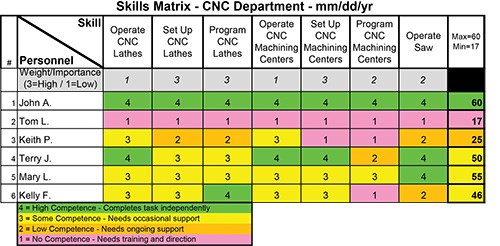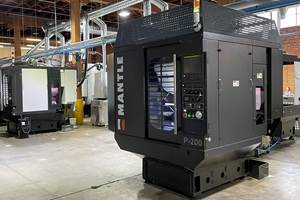The Ongoing Need for Cross-Training
Managing its effectiveness also will help build a highly skilled workforce.
Share






In prior columns, I have discussed the importance to any organization of a well-trained, highly skilled workforce. Although a component of increased employee skills may be provided externally through schools, training organizations and trade associations, skills training is mostly delivered internally. For most jobs, cross-training is the fastest and most effective means of increasing skills. Effective cross-training, during which employees learn from each other, allows job-specific skills to be absorbed and applied in the workplace. As a result, most employees get up to speed at a faster rate. Although not everyone can be a great trainer, almost anyone can show others how they do certain things, and this is the first step to raising the skills of others.
Managing the effectiveness of training is critical to any successful skills-enhancement effort. For a number of years, I have used a simple matrix that has been effective in recording and communicating employee skill levels, as well as targeting areas where further training is required. Color makes the skills matrix highly visual and even more useful.

In the sample skills matrix for a CNC department above, the ratings used and color code employed show that John A. is a truly valuable employee and exhibits a high level of competence in each of the seven skills being evaluated. Terry J. is also a highly skilled employee with high competence in four skills and further competence in others. Mary L. exhibits high or some competence in all skills, while Keith P. and Kelly F. have a varied range of competences. It is likely that Tom L. is a new employee with little competence displayed thus far. The final column provides a numerical total, and each employee’s total is color-coded in line with the color-coding of the individual skills to provide a frame of reference.
All of this information is useful in evaluating the employees in the CNC department, but this matrix assumes that each skill shown is equally important. However, in the “real world,” this is rarely the case. Inevitably, employers value some skills higher than others, so it is helpful to add a weighting to each skill being evaluated. The modification to the matrix here does just that:

In this version of the matrix, a level of importance has been assigned to each skill. Although weighting techniques will vary, I have used three categories, with “3” representing highest importance, “2” moderate importance and “1” lowest importance (although, obviously, each skill is important). The weighting changes the overall competence scale significantly. Whereas in the initial matrix the highest level of competence was reflected in a maximum rating of 28, in the modified matrix the highest weighted level of competence receives a rating of 60. Additionally, the introduction of weighting changes the overall competence rating of two employees. Terry J. was considered an overall “High Competence” performer in the initial matrix, however, when the importance of each skill is factored in, an overall rating of “Some Competence” is more appropriate. Kelly F. actually increases from being a “Low Competence” performer in the initial matrix to a “Some Competence” performer in the revised matrix. The skills in which Kelly F. excels are considered more important than those for which she received a lower rating.
The weighting of skills increases the value of the matrix, and this feature should be considered when developing one of your own. I think you will find a skills matrix to be a useful tool as you strive to continuously upgrade the skills of your employees.
Related Content
In Moldmaking, Mantle Process Addresses Lead Time and Talent Pool
A new process delivered through what looks like a standard machining center promises to streamline machining of injection mold cores and cavities and even answer the declining availability of toolmakers.
Read MoreBuilding Machines and Apprenticeships In-House: 5-Axis Live
Universal machines were the main draw of Grob’s 5-Axis Live — though the company’s apprenticeship and support proved equally impressive.
Read MoreFinding the Right Tools for a Turning Shop
Xcelicut is a startup shop that has grown thanks to the right machines, cutting tools, grants and other resources.
Read MoreShop Tour Video: You've Never Seen a Manufacturing Facility Like This
In the latest installment of our “View From My Shop” series, explore Marathon Precision’s multi-process approach to manufacturing, where blacksmiths and hand-forged dies meet state-of-the-art CNC machining. Discover how restoring classic muscle cars and building custom art projects creates a dynamic shop culture — and draws top talent to this unique and innovative metalworking facility.
Read MoreRead Next
AMRs Are Moving Into Manufacturing: 4 Considerations for Implementation
AMRs can provide a flexible, easy-to-use automation platform so long as manufacturers choose a suitable task and prepare their facilities.
Read MoreMachine Shop MBA
Making Chips and 91ÊÓƵÍøÕ¾ÎÛ are teaming up for a new podcast series called Machine Shop MBA—designed to help manufacturers measure their success against the industry’s best. Through the lens of the Top Shops benchmarking program, the series explores the KPIs that set high-performing shops apart, from machine utilization and first-pass yield to employee engagement and revenue per employee.
Read MoreLast Chance! 2025 Top Shops Benchmarking Survey Still Open Through April 30
Don’t miss out! 91ÊÓƵÍøÕ¾ÎÛ's Top Shops Benchmarking Survey is still open — but not for long. This is your last chance to a receive free, customized benchmarking report that includes actionable feedback across several shopfloor and business metrics.
Read More


















